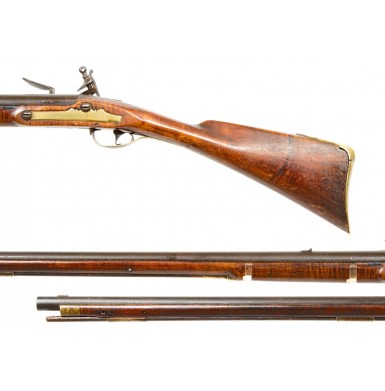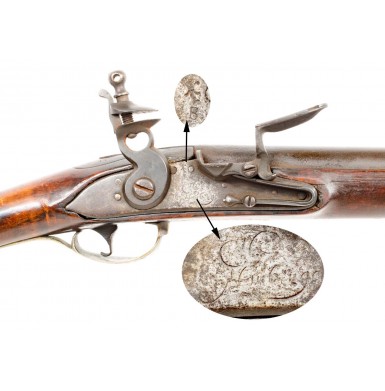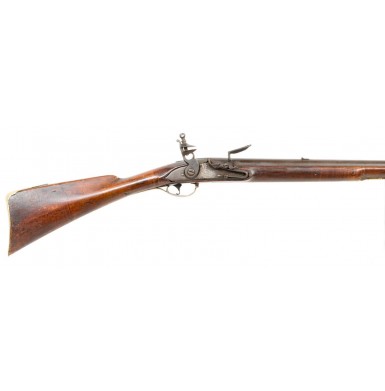Kentucky Fowler - An American Restock of French Parts
- Product Code: FLA-3489-SOLD
- Availability: Out Of Stock
-
$1.00
During the first half of the 18th century, few long arms were more representative of the guns carried in the woods of much of North America than the French “Fusil de Chasse”, literally meaning “hunting gun”. The “fusil de chasse”, along with its contemporaries the “fusil de traite” (trade gun) and the “fusil de fin” (fine gun, a higher-grade trade gun with more ornamentation), were differentiated from the gun they had been derived from, the “fusil ordinaire” (“ordinary” or “typical” gun), by a number of features that adapted them to their purpose. The Fusil Ordinaire was the standard French infantry musket of the period. While the French had been providing hunting and trade guns to the North American continent since the 1600s, these guns often differed little from the French military arms then in use, and realistically there was little uniformity in pattern or design for either the military or trade arms. During the last decade of the 17th century and the first decade of the 18th century, the French attempt to begin standardizing patterns of arms, both for military use and eventually for economic and diplomatic use in trade. During the period when some of the first standardized French hunting and trade fusils were being produced, the gun that was their inspiration was the French Model 1717 musket. The M1717 was long, heavy and well designed to serve as a combat musket for that period. It was nominally 63” in overall length, with a 46 ¾” .69 caliber smoothbore barrel. It was not short, light and handy and thus was poorly suited for use in the thickly wooded areas of North America. The French solution was to produce a shortened and lightened version of the guns, usually with an overall length of 60” or less. The barrels of the fusils were typically between 42”-46” long, the caliber was reduced to around .60-.62 and most importantly the stocks were thinned and slimmed, making the guns sleek and handy. These lighter guns often weighed about 2/3 of the weight of the comparable pattern military musket, were much better balanced and had a graceful sloping line to the butt, referred to by the French as a “pied a vache” (“cow’s foot”) design. In English, this distinctive French butt shape became known as the Roman Nose pattern. A graceful design so aesthetically pleasing and functional, it would become one of the features most associated with American gun makers of the 18th and 19th centuries and would be found incorporated into the designs of colonial era musket fowlers from New England to Golden Age Kentucky Rifles from Pennsylvania.
During the colonial period, the American gunsmith relied heavily upon parts that were imported from England and Europe, and often utilized parts scavenged from other guns that were no longer serviceable. In particular, locks and barrels, often from damaged military arms, often found their way into American assembled arms, both for use by the military and civilians. Many of the arms were remanufactured into the musket fowler, a dual purpose smoothbore long arm that was equally at home putting game on the table or doing service as a militia musket.
Offered here is a very attractive, solid example of a “Kentucky” Fowler, in this case an American Restocked Flint Long Arm from French Parts, in a Bucks County Style. The gun measures 59” in overall length, with a 43 1/8” pinned, round, smoothbore barrel. In the classic Kentucky Fowler form, the gun incorporates a fixed notch rear sight 7 1/8” from the breech, in conjunction with a 1” long, brass blade front sight, located 1 1/8” from the muzzle. The use of this type of rear sight on smoothbore longarms is typical of the “Kentucky” style fowler, which was typically produced without a patchbox and with a rounded triggerguard. The smooth bore measures about .70” and appears to be a repurposed French barrel, probably from a French musket. It is marked with a large Band Punder the barrel and has had four small pin tenons dovetailed into the bottom surface. The only external marking on the barrel is a small 73 at the left breech, possibly indicating the year the barrel was produced. The lock is a repurposed French military musket lock that appears to be from a Model 1763/66 musket. The lock plate is flat, measures the standard 6 5/16” of a M1763/66 lock, and has the usual teat at the lock’s rear. The lock utilizes a removable, fenced and bridled iron pan and a flat, beveled, reinforced cock. The frizzen shows a wonderful period refacing (sometimes called “shoeing”), indicating a service life that required the steel to be resurfaced to keep the gun in operation. The lock is marked in script Maubeuge, indicating that is was produced at the Maubeuge Arsenal, and additionally marked with a */Binspection between the cock and the pan. The inside of the lock is marked with a P and an Rinspection mark. The lock is retained by two lock screws that pass through a 5 ½” long, flat brass side plate that is typical of mid-to-late 18thcentury Pennsylvania made long arms. The relief cast, rounded brass triggerguard is likely of English or Continental origins and incorporates classical motifs with some flowing foliate scrolls and an urn shaped finial. Inside the triggerguard is an iron trigger, suspended from a stock pin, that has a substantial reward curl at its end. The buttplate appears to be an American made copy of the simple furniture often found on the French fusils. It is secured by two screws through the bottom and has a stepped, geometric tang that is roughly 3 ½” in length and terminates in a point. A 1 1/6” sheet brass reinforcement is present at the forend to reduce the possibility of the stock splitting. The design does not use an actual nose cap, simply this reinforcing strip. The only other furniture are two sheet brass ramrod pipes and an entry pipe. The two upper pipes measure 2 ¼” and 2 1/8” respectively are somewhat crudely formed and have baluster turned rings near their ends. The entry pipe is 3” in length and has matching baluster turned rings. The pipes retain a 42 5/8” wooden ramrod that shows some decent age and wear, which may or may not be original to the gun. The two lock screws and the tang screw are handmade of the period and fit the gun and their associated parts perfectly. While the lock and barrel are of French origin, and the triggerguard appears to be a non-American made piece as well, the rest of the furniture appears to be American made, and there is no doubt that the stock is of American origin as well. It retains the distinctive Roman nosed profile of French fusil stocks that were adopted by the Pennsylvania gunmakers, who made it a distinctive feature of the “Golden Age Kentucky Rifle.” The gun has a graceful 1 ¼” drop at the comb, a 3” drop at the heel and a relatively short 13” length of pull from the center of the buttplate to the iron trigger. While the butt retains the basis of the graceful French lines, they are executed in a very workman like fashion and overall the stock is slightly blockier and sturdier than an original French stock, although the wrist remains fairly slender. The stock does not incorporate the pronounced rail to the butt, commonly found on French-made fusils. The stock shows some simple incised line carving that mimics the English “beaver tail” apron around the tang and which is also present in a double line from the lock to the entry pipe on each side of the stock. This style of decoration is another feature indicative of guns built in the Bucks County region of Pennsylvania. The gun is handy and well balanced, weighing in at a about 7.5 pounds, about ¾ of the weight of a period military musket.
The gun remains in about VERY GOOD+ condition, as modified during the period of use. The iron components show a thickly oxidized brown patina over most of the metal, with the lock cleaned slightly to make the markings more legible. The barrel shows some lightly scattered pitting over most of its length, with more moderate pitting around the breech area. The touchhole shows some moderate erosion and pitting but no indication of re-conversion. It remains well centered in the pan and is appropriately angled and tapered. The lock shows light pitting as well, with the heaviest pitting being in the pan and around that part of the lock. The lock remains functional but does show some expected wear. The lock appears to remain in its original flintlock configuration with the original iron pan that has not been rewelded or reattached to the lock plate. The steel (frizzen) is worn, with an old refacing that is chipped at the right side and shows significant use. The steel (frizzen) fits the pan perfectly and matches its appearance, wear and oxidation perfectly as well. The cock is a replacement that is very high quality and appears to be an original that has been chemically treated to more closely match the balance of the gun. Inspection of the breech from the inside via a remote camera system reveals absolutely no molestation or reconversion of the breech area. The ramrod pipes have an uncleaned patina deep mustard patina, as does the reinforcing band at the nose. The triggerguard and buttplate have a more mellow, golden patina, with the buttplate showing a crack at the upper corner, through the screw hole, below the tang. The bore of the gun is in about GOOD condition. It shows heavy oxidation, is dark and dirty and appears to be moderately to severely pitted along its length. The stock remains relatively solid for a gun that is well over 200 years old and approaching 250 years old. As is typical of guns of this pattern and age, the stock shows some repairs, particularly in the forend. The most significant repair is some damage just forward of the middle pipe, where there has been epoxy added on the interior of the stock to reinforce weakness and cracks. This is not really visible externally, although the cracks can be seen under close scrutiny. Only two pins currently secure the forend. The rear most one is quite old and may be period. The one forward of the middle pipe is a modern replacement. No other pins are present to secure the stock, although the pins that secure the pipes are present. There is also a repaired 5” long crack along the upper edge of the stock, forward of the lock mortise. A much smaller crack is present forward of the triggerguard. A small piece of wood is chipped out of the lock mortise under the lock at it rear, that appears to be the result of sear arm wear. A small crack is also present at the rear lock screw, running to the barrel channel. The stock has been refinished long ago with the added stain not materially affecting the attractiveness of the stock but doing a good job of concealing the wear and repairs in the forend. There is also an added layer of varnish, that now has a somewhat alligatored, on the wood.
Overall this is a really attractive and very interesting American Restock of French Parts into a Bucks County Style Kentucky Fowler that remains in original flint and with some of the major components being salvaged from a French musket. It is hard to know exactly when the gun was restocked, but the styling suggests circa 1780-90, although it could be earlier. The lock and barrel as well as some of the furniture are almost certainly circa 1760s-1770s, with some of the furniture primarily the brass components somewhat later, and mostly American made. These American composite guns have a truly interesting history, as they went through numerous repairs and even complete rebuilds to keep them functional and is service. Most of the components for this gun were certainly in service during the period of the Revolutionary War, but not likely with this stock. The stock allowed the gun to remain in use into the period of the 19th century, and possibly to the period of the War of 1812, although it is unlikely that saw any military use at that time. This is a very attractive example of a classic American Composite Kentucky Fowler that displays very well.
















